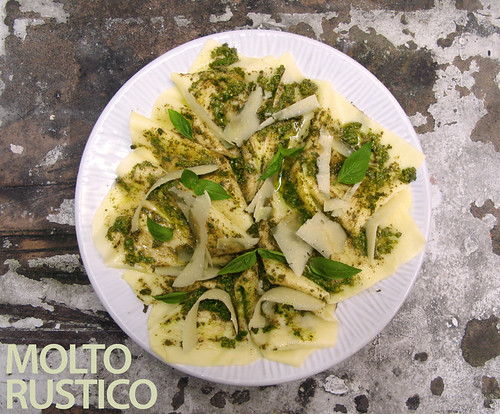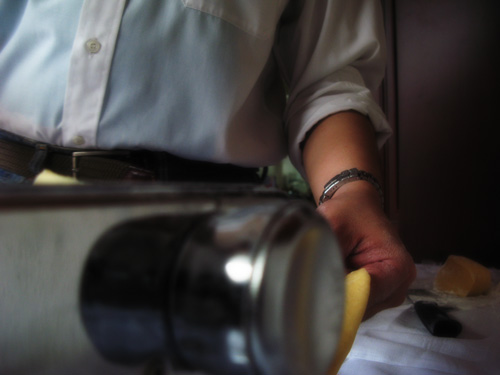Silk Handkerchiefs with Pesto Sauce
Fazzoletti di Seta al Pesto
I get a few casual requests to cook for or teach people to cook (actually, replace "cook" with "bake" and that will be closer to the truth). One of the reasons I started blogging about food in the first place is to show people that we can all start from zero and make something we'd be proud of. We can all learn together, people! I'm not sure what possessed me one morning to wake up and decide that I would be cooking or baking at least one new thing each week, but it worked out and a few months later (yes, really), I have a bunch of new skills at my disposal. A lot of my friends eat at awesome restaurants regularly-- maybe I was inspired by envy?
Anyway, I was chatting with Graeme about Jamie Oliver and there's quite a bit of ridicult directed at him for being over-the-top and cloying (and some are cynical of his attempts to train disadvantaged people to become chefs), but I don't care (I realize I accidentally typed "ridicult" up there. I like it, it's my made-up word of the year.). The man can cook, and that's pretty much all that matters. I'm not much of a vegetable fiend but I'm learning, thanks to him (and cursing the lack of diversity in the markets, too, thanks to him). I'm grateful too, since his book that I picked up at a used/surplus bookstore (more on my obsession with used book sales in a later post) finally pushed me to make my own pasta due to its gorgeous photographs. (Recipe follows)
Me on the pasta machine with my amazing body that can stand to do a sit-up (or five hundred). The view could be better, but if I get a speck of flour in my brother's camera's lens, there would be a Cain and Abel situation going on.
Anyway. For each person you want to allow 85g (3 ounces or 1/2 cup plus 1 tablespoon) all-purpose flour and 1 large egg (or 2 egg yolks for a yellower pasta). The recommended flour is Italian Tipo 00 flour (soft, tender, fine-sieved), but good grief, don't kill yourselves, people. I'm feeding four, so I use 12 ounces of flour and 4 eggs. Make a well in the mound of flour on your clean, dry work surface (or bowl), then crack the eggs into the well. Using a fork, beat the eggs until smooth, then start incorporating the flour from the sides, taking care not to break the well until most of the flour is mixed into the eggs. When it has, flour your hands and start kneading the shaggy dough, letting all your frustrations out for at least 3 minutes, when your dough has turned silky and elastic. Wrap in cling film and leave in the fridge for at least 30 minutes while you work on the pesto.
For some reason we have basil growing in our backyard, so: organic pesto! It's very lemony and strong, and I'm not sure if it's Thai Basil but the stems aren't purple. Pick at the leaves and wash, then pat dry. I'm using a blender, which I think funnily enough is below the mortar and pestle (and way below the food processor) in the hierarchy of pesto-making. Unfortunately our mortar and pestle is tiny and did a very good job of making the leaves brown with my excessive pounding (heh), so I switched to a blender.
Annoying ingredient list, eh? Welcome to Italian cooking. And good luck weighing basil leaves. In a food processor or mortar and pestle, grind up the leaves with the garlic, pine nuts, cheese, and salt. If using a blender, stop pulsing every now and then to drive leaves to the bottom with a long spoon. Jamie suggests that if you use the mortar and pestle, mash the pine nuts separately and mix in with the leaf mush. I don't know why. With the motor running, pour the oil in a thin stream until the resulting pesto is oozy. If using a mortar and pestle, you can just whisk in the olive oil. Give the pesto a taste and add black pepper to your taste, and more salt, if needed (I find that a healthy-sized pinch is required). Set aside.
Divide the pasta dough into as many sections as the number you'll feed. Set your pasta machine on the thickest setting for the rollers (7 on my machine), then run one of the dough balls through, then fold and repeat at least once more. You want the pasta to be about 3-4 inches wide, so manipulate the dough by folding and rolling to approximate this. It's my first time to use a pasta machine (for pasta at least), but my best advice is that after you've set the rollers to a thinner setting, you can no longer fold your pasta. It'll destroy your pasta.
Dust the rolled-out pasta with flour lightly, slapping out the excess. Set the rollers at the next-thickest setting (6 on my machine... obviously) and run the pasta through it twice. Cut the resulting long pasta into 2 shorter sheets so you can manage better. Continue the cycle (you don't usually need to dust it with flour again, though) of adjusting the rollers and running the pasta twice until you've made it very thin (2 on my machine, 1 being the thinnest). You should be able to kind of read a newspaper through it. Cut the long pasta sheets into coaster-sized portions and lay in one layer on a damp tea towel to prevent in from drying out while working on the other dough balls.
It may seem like a lot of work, but it is a lot of fun!
Anyway, bring about 1-1/2 gallons (5-6 liters) of water to a rolling boil and add a generous pinch of salt. Drop the silk handkerchiefs in, stirring occasionally to prevent sticking, and boil for 3 minutes. There won't be enough room to boil all of them at once, so use a strainer or a spider to fish them out into a colander while you work on the rest of the pasta. Reserve about a cup of the hot cooking water.
Using a vegetable peeler, make a few shavings of the cheese. Grate the rest. Toss the cooked pasta with the pesto and the grated Pecorino cheese. If the pasta appears too tight, loosen it with the hot cooking water, a tablespoon at a time. Top with the basil leaves and Pecorino shavings.















































